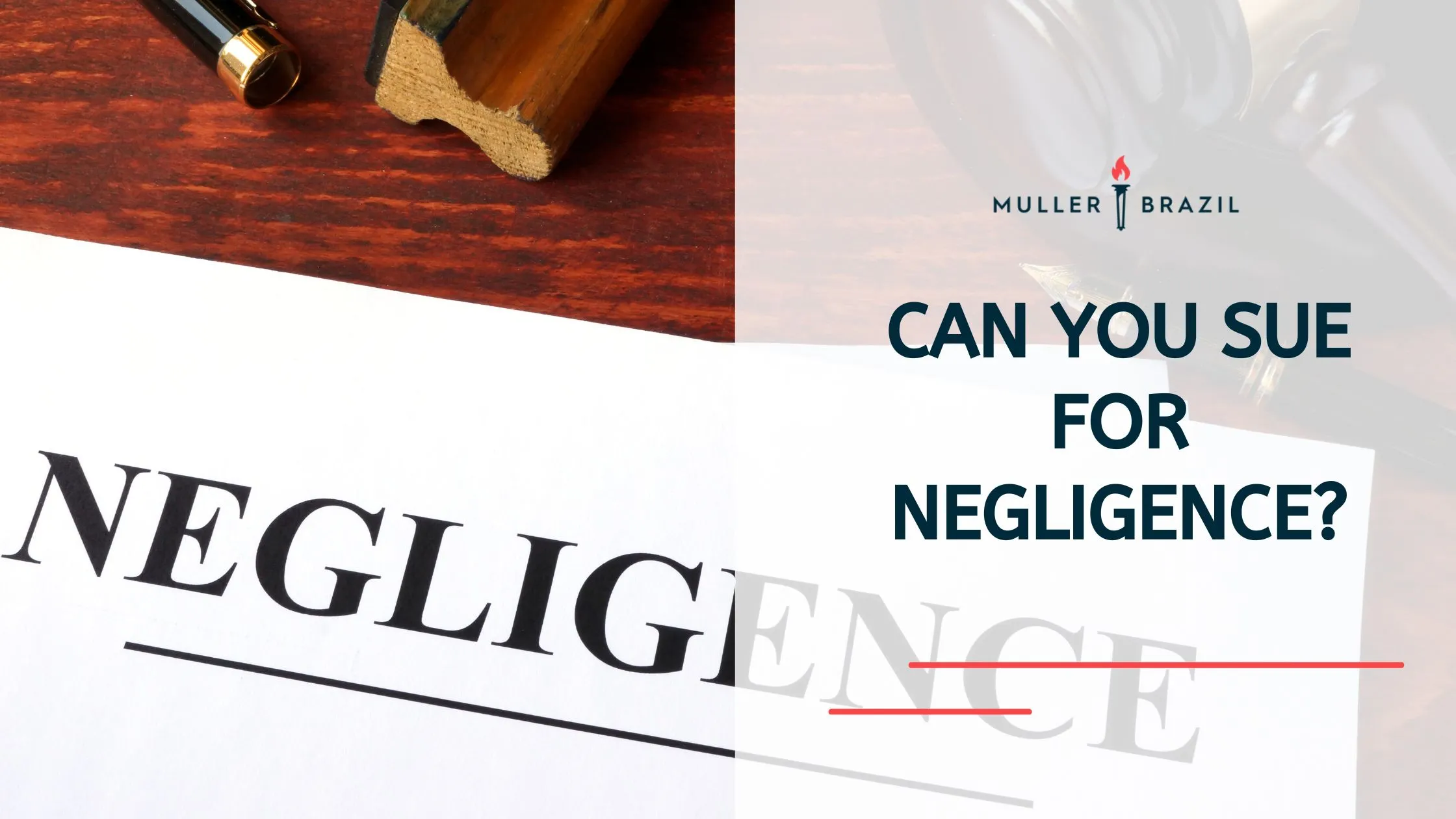9 min read
Can You Sue for Negligence? Proving Fault and Seeking Justice
![]() Paul R. Brazil, Esquire
Dec 12, 2023 10:56:07 PM
Paul R. Brazil, Esquire
Dec 12, 2023 10:56:07 PM
Every year, thousands of negligence claims are filed in Pennsylvania alone, with cases ranging from car accidents and medical malpractice to workplace injuries and unsafe property conditions.
Negligence lawsuits serve as a pathway for injured individuals to hold others accountable, providing victims with the opportunity to secure compensation for their losses. If you've been harmed due to someone else's carelessness, understanding the essential elements required to prove a negligence claim can be your first step toward justice. This guide will walk you through the key steps involved in filing a negligence lawsuit, from establishing duty of care to calculating damages, helping you build a strong case with the right legal guidance.
Understanding Negligence: Can You Sue?
A negligence lawsuit allows an injured person to seek compensation when someone else's lack of care causes harm. By proving the responsible party failed in their duty to act safely, the injured can recover costs for things like medical bills, lost wages, and pain. This legal process emphasizes accountability and encourages safer practices, providing a pathway for victims to rebuild their lives after an injury. The ability to sue for negligence hinges on whether all the required elements have been met, including:
- Duty of care
- Breach of duty
- Causation
- Damages
Securing the services of a seasoned lawyer from a reputable law firm, like Muller Brazil, significantly boosts your chances of a favorable outcome in a negligence case, as they offer expert guidance, particularly when it comes to demonstrating that the defendant violated their duty of care.
Definition of Negligence
Negligence is a legal term meaning a failure to exercise the degree of care that a reasonable person would have taken in a comparable situation, leading to harm to another person. It is distinguished from other legal terms as it refers to wrongful conduct that results in injury to another due to a lack of reasonable care. Just a few examples of negligent acts include car accidents, medical malpractice, and premises liability.
In negligence cases, the law determines ‘harm' by examining the compensable losses suffered by the victim due to the negligent action or inaction. To establish negligence and pursue compensation, one must show that the defendant's actions were negligent and directly resulted in the plaintiff's harm.
Types of Negligence
There are various forms of negligence, such as:
- Gross negligence implies an extreme disregard or indifference for the safety of others
- Criminal negligence involves reckless behavior that results in harm or death
- Vicarious liability holds one person accountable for the actions of another when they are engaged in a joint activity
- Contributory negligence occurs when the plaintiff's own negligence contributes to their injury
- Comparative negligence assigns fault and damages based on the percentage of negligence attributed to each party involved
Contributory negligence is a legal doctrine where the plaintiff is partially responsible for their own accident. For example, if a driver texting while driving collides with another driver who makes an illegal turn, both drivers may be deemed partially responsible. In these scenarios, the jury might deem the plaintiff partially liable, potentially preventing them from securing compensation.
Proving Negligence: The Four Essential Elements
For a successful negligence lawsuit, you must establish four key elements:
- Duty of care
- Breach of that duty
- Causation
- Damages
Establishing that the defendant owed the plaintiff a legal obligation to act with a certain level of care is the first step in proving negligence. This legal obligation, the duty of care, is important in negligence cases, as it sets the standard for the defendant's responsibility towards the plaintiff.
Once the duty of care is established, the plaintiff must demonstrate that the defendant breached this duty, known as the breach of duty. Proving causation requires showing that the defendant's negligence directly caused the plaintiff's injury and that the injury was foreseeable.
Finally, the plaintiff must prove that they suffered harm due to the defendant's negligence in a personal injury lawsuit, typically resulting in monetary compensation for expenses like medical bills or property damage related to the plaintiff's injury.
Duty of Care
The duty of care is a legal obligation requiring an individual to act with reasonable care to avoid causing harm to others or their property. In negligence cases, this duty is the initial element that must be confirmed to prove negligence. The standard of care in negligence involves the level of caution that a reasonably intelligent person would exercise in a similar situation.
Establishing a duty of care is important in determining the defendant's legal liability in a negligence case. For example, a doctor owes a legal duty of care to their patient, and a driver owes a duty of care to other road users.
The assertion that the defendant had a duty of care towards the plaintiff forms the bedrock of the entire negligence claim.
Breach of Duty
Breach of duty is defined as the failure of the defendant to meet the required standard of care. In negligence cases, this standard of care is that of a reasonably prudent individual. Expert testimony from professionals like engineers and physicians is often necessary to demonstrate a breach of duty.
The “reasonably prudent person” standard is a legal benchmark reflecting how a typical individual would act responsibly in a given situation. By comparing the defendant's actions to those of a reasonably prudent person, the court determines if the defendant breached their duty of care, which is essential in proving negligence.
Causation
Causation is the determination that the defendant's negligence directly resulted in the plaintiff's injury and that the injury was foreseeable. To establish causation, it must be demonstrated that the defendant's actions or lack thereof directly caused the plaintiff's injuries or harm. This is commonly referred to as ‘but-for' causation, meaning that, had it not been for the defendant's actions, the plaintiff's injury would not have occurred.
Establishing causation is a tough task, as it requires demonstrating a direct correlation between the defendant's negligence and the plaintiff's harm. However, it is a crucial element of a negligence claim, as it demonstrates that the defendant's breach of duty was the proximate cause of the plaintiff's injury.
Damages
Damages indicate that the plaintiff has suffered harm due to the defendant's negligence, usually resulting in financial compensation for costs such as medical expenses or property damage. To calculate damages in a negligence case, evidence such as medical records, documentation of incurred medical expenses, and proof of lost wages is required.
Typically, compensatory and punitive damages are awarded in negligence cases. Compensatory damages cover the plaintiff's actual losses, while punitive damages punish the defendant for particularly nasty conduct. Effectively substantiating damages is critical in achieving compensation in a negligence lawsuit.
Examples of Negligence Cases
Real-world instances of negligence lead to lawsuits, providing valuable insights into the complexities of these cases. Examples include:
- Car accidents caused by negligent driving
- Medical malpractice due to healthcare professionals failing to provide the appropriate standard of care
- Premises liability involving property owners who fail to maintain a safe environment for visitors.
Understanding the diverse types of negligence aids you in recognizing when you have a legitimate claim and in seeking the professional assistance of a personal injury attorney to help you pursue justice. By familiarizing yourself with these examples, you will better manage the legal complexities of negligence cases and make informed decisions about your own situation.
Car Accidents
Negligent driving, such as speeding, tailgating, or texting while driving, can result in car accidents and injuries. Speed is a significant factor in negligent driving, and drivers exceeding the speed limit or driving at an unsafe speed for conditions may be considered to have acted negligently. Demonstrating that a driver was guilty for speeding requires evidence, such as witness testimonies or surveillance footage.
Texting while driving is another example of negligent driving with severe legal ramifications, including fines, license suspension, or even imprisonment if injuries or death are caused. By understanding the consequences of negligent driving, individuals take necessary precautions to prevent accidents and hold those responsible for their actions.
Medical Malpractice
Medical malpractice occurs when a healthcare professional fails to provide the appropriate standard of care, resulting in harm to a patient. Common examples of medical malpractice include:
- Misdiagnosis
- Medication errors
- Surgical errors
- Birth injuries
- Hospital negligence
Patients have legal rights in the event of medical malpractice, including the right to:
- Demonstrate the existence of a professional duty owed to them by the healthcare provider
- Show that the duty was breached
- Prove that the breach of duty resulted in harm to the patient
- Request compensation for damages
By understanding medical malpractice cases, patients better advocate for themselves and seek compensation for their injuries. See our blog on medical malpractice attorneys for more information.
Premises Liability
Premises liability cases involve property owners who fail to maintain a safe environment for visitors, leading to injuries from hazards like:
- Slippery floors
- Broken stairs
- Uneven walkways
- Inadequate lighting
- Falling objects
Property owners are responsible for maintaining a safe environment on their property. This includes fixing any dangerous conditions and warning visitors of potential hazards.
Property owners may be held accountable for any injuries on their property if they do not follow their obligations. Understanding premises liability cases helps individuals recognize when they have a valid negligence claim and seek the assistance of a personal injury attorney to pursue compensation.
The Role of Personal Injury Attorneys
Legal professionals play a vital role in helping individuals navigate the complexities of negligence cases. A Philadelphia personal injury attorney offers assistance in:
- Investigating the case
- Evaluating damages
- Constructing a legal case
- Mediating settlements
- Representing the client in court
- Providing legal advice
Engaging an attorney's services significantly increases the chances of a successful outcome in a negligence lawsuit.
Many personal injury lawyers provide complimentary initial case assessments to determine whether you have a valid personal injury claim. Additionally, personal injury attorneys often work on a contingency basis, meaning they only get paid if they successfully recover your compensation. This fee structure allows individuals to seek legal representation without the burden of upfront costs, ensuring that justice is accessible to all.
Free Consultations
Free initial case evaluations or free consultations provide an opportunity for individuals to:
- Discuss their negligence case with a personal injury lawyer without any cost or obligation
- Provide information about their circumstances
- Ask questions
- Gain an understanding of how the attorney may be able to assist them
During the consultation, individuals have a productive conversation and gather the necessary information to make informed decisions about their case.
When engaging in a free consultation, individuals should be prepared to fully recount their story, provide any available evidence, and ask questions about potential legal claims and the lawyer's qualifications. This consultation serves as an opportunity to evaluate the attorney's expertise and determine if they fit the individual's needs.
Contingency Fees
Contingency fees refer to the payment arrangement wherein personal injury attorneys only receive remuneration upon successfully recovering their clients' compensation. This fee structure benefits clients by eliminating upfront fees and reducing the risk of pursuing a negligence claim. See our blog on how much a personal injury attorney costs for more information.
However, there are potential drawbacks to this type of fee structure, such as increased costs in the event of a swift settlement and reduced client autonomy. Despite these drawbacks, contingency fees provide a viable option for individuals seeking legal representation in negligence cases without the financial burden of paying attorney fees upfront.
Overcoming Defenses to Negligence
In negligence lawsuits, defendants may raise various defenses to counter the plaintiff's claims, such as contributory negligence and assumption of risk. Strategies for addressing these common defenses include contesting the plaintiff's negligence, demonstrating the defendant's negligence, demonstrating comparative negligence, and refuting the assumption of risk.
Recognizing these defenses and identifying how to combat them is vital to successfully advancing a negligence claim. By being well-prepared and working with an experienced personal injury attorney, individuals increase their chances of overcoming these defenses and obtaining the compensation they deserve.
Comparative Negligence
Comparative negligence is a legal doctrine that allocates responsibility between the plaintiff and the defendant, with the plaintiff's compensation being reduced by their percentage of fault in the incident. In a comparative negligence case, the court evaluates the actions and behavior of all parties involved and assigns a percentage of fault to each party. This percentage determines the amount of damages each party is accountable for.
Comparative negligence provides a more equitable approach to determining damages in negligence cases, as opposed to contributory negligence, which may completely preclude the plaintiff from obtaining compensation if any degree of fault is attributed to them. Understanding comparative negligence helps individuals better proceed with their negligence claims and seek fair compensation for their injuries.
Assumption of Risk
Assumption of risk is a defense arguing that the plaintiff knowingly and voluntarily assumed the risk of injury, potentially barring them from recovering damages. To counter this defense, it may be necessary to demonstrate that the defendant's behavior was not negligent or that the assumption of risk was not voluntary or informed. Additionally, it could be argued that the defendant's actions were reckless or intentional, which would supersede the assumption of risk defense.
Being aware of the assumption of risk defense and knowing how to counter it significantly impacts the outcome of a negligence claim. By working with a knowledgeable personal injury attorney, individuals develop a solid strategy to overcome this defense and pursue the compensation they deserve.
Summary
Managing negligence cases is daunting, but understanding the various aspects of negligence, the essential elements required to prove it, and the role of personal injury attorneys equips you with the knowledge needed to seek justice. By being well-informed and working with an experienced legal professional, you effectively counter common defenses, overcome the challenges of proving negligence, and secure the compensation you deserve. Remember, your pursuit of justice is not only about your well-being but also about holding those responsible for their actions and making the world safer for all.
Frequently Asked Questions
What is needed to win a negligence case?
To win a lawsuit for negligence, the plaintiff must prove four elements: duty, breach, causation, and damages/harm. These elements must be clearly demonstrated in court to establish legal liability and succeed under personal injury law.
What would be considered negligence?
Negligence is legally defined as the failure to exercise a reasonable degree of care, resulting in injury or harm to another person. To establish negligence in a lawsuit, one must prove duty, breach, causation, and damages, all critical components in negligence law.
How do you prove negligence damages?
To prove damages in a lawsuit for negligence, the plaintiff must show the defendant owed them a duty of care, breached that duty, and that this breach directly caused the injury. Personal injury law requires victims to demonstrate compensable damages, such as medical expenses or lost income.
Is it difficult for someone to prove negligence?
Proving negligence under personal injury law can be difficult, requiring substantial evidence and thorough documentation. The plaintiff's degree of fault can also influence the outcome of the lawsuit for negligence.
What are the four essential elements required to establish negligence?
To establish negligence under negligence law, one must demonstrate duty of care, breach of duty, causation, and damages. Proving these elements is essential for a successful lawsuit for negligence.
Meet the Author
Paul Brazil - Founding Partner
Paul Brazil is a native of Dunmore, Pennsylvania and a graduate of Dunmore High School. For his undergraduate education, he attended Bloomsburg University where he majored in political science. He then went on to earn his JD from Widener University School of Law. Following graduation from law school, Mr. Brazil worked at a large Philadelphia civil defense firm where he litigated workers’ compensation claims and Heart and Lung Act cases.
Learn more about Paul Brazil ⇒





-1.jpg?width=616&height=347&name=MB%20(1)-1.jpg)

